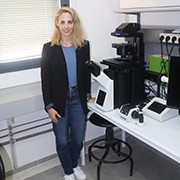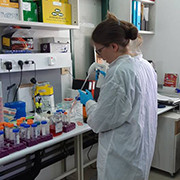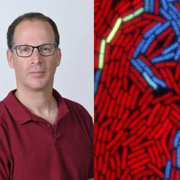How to Copy Billions of Letters in a Couple of Hours?
Prof. Martin Kupiec studies the proteins that drive replication and cause mutations in DNA
DNA replication is one of the most basic processes in biology, without which cells cannot divide, and life could not develop. However, it is also an unfathomably complex process, in which the cell is required, in the case of the human genome, to copy 3.5 billion bases, or "DNA letters," in just a few hours - and do it as accurately as possible. To accomplish this tremendous task, cells have dedicated mechanisms for overcoming bugs that stop the replication process. Some of these bug-bypassing mechanisms do so with high fidelity, preserving the original DNA information, while others fill in the problem-causing DNA segments with random letters, thus introducing mutations into the genome.
"Three out of four mutations found in any organism are created by this mechanism," explains Prof. Martin Kupiec of the Shmunis School of Biomedicine & Cancer Research at Tel Aviv University. "Mutations are usually thought to be unfortunate, disease-causing mistakes. However, mutations also create variation in populations and enable natural selection and evolution." Prof. Kupiec is studying the mechanisms maintaining the stability of the DNA and its accurate replication from cell to cell.
In a new paper published in the International Journal of Molecular Studies, researchers in his lab discovered a key feature in the process of choosing between the different bug-bypassing mechanisms and determining if a mutation will be added to the newly formed DNA or not. In addition to deepening the understanding of crucial processes in biology, this discovery could also shed light on the development of cancer and other human diseases.
Turning a Lamborghini to a Jeep
"Why does the cell use mutagenic repair if non-mutagenic alternatives exist? Cells have to finish copying all the genome, and time is of the essence. You could imagine the DNA replication process as a Lamborghini driving down the road, until it reaches a big pothole in the road. If it does not continue, the cell is unable to finish copying the genome. The solution: the Lamborghini is changed by a jeep that slowly passes the pothole, and afterwards the Lamborghini returns to its high-speed drive," says Prof. Kupiec. "In this analogy, the jeep is an inaccurate and slow enzyme that bypasses the pothole, but leaves behind mutations".
To better understand DNA replication processes and how the decision between the "Lamborghini" and "jeep" mechanisms is made, Prof. Kupiec’s lab is using bread- and beer-making yeast. "Yeast cells are very similar to human cells in their basic mechanisms, but it is much easier to culture them and use them to answer interesting and basic, universal questions about biology.”
The decision of which mechanism to use depends on the intricate dance of multiple proteins and molecules involved in the DNA replication process. Previous research by his lab and others was able to identify different bug-bypassing mechanisms and focus on PCNA as a specific protein playing a significant role in determining which of the mechanisms will be used each time the replication process gets stuck.
Breaking the Ring
The basic function of PCNA is to encircle the DNA strand and hold the mechanism doing the replication process in place. This protein is composed of three identical parts connected to each other, forming the ring. To better understand its role in DNA replication, Prof. Kupiec, together with Matan Arbel-Groissman and Batia Liefshitz, used mutations weakening the connections between the three subunits - causing it to easily break up and disconnect from the DNA.
Comparing the cells with the easily breakable PCNA to yeast cells without the mutation revealed that the presence of the ring-shaped protein prevents the activation of the mutation-inserting bug-bypass mechanism (the "jeep"). Additional experiments measuring the influence of other proteins interacting with PCNA, by knocking them out and seeing how their absence changes these processes, showed their involvement in maintaining the stability of the protein ring on the DNA during the replication process and preventing the activation of the mutation-inserting mechanism.
"Our results shed light on the decision-making mechanisms of the cell, which may result either in the creation of mutations, sometimes life-threatening, or in the accurate copying of the genome. We obtain a glimpse on the basic mechanisms that shape evolution, as well as those determining human aging and cancer development," says Prof Kupiec.





